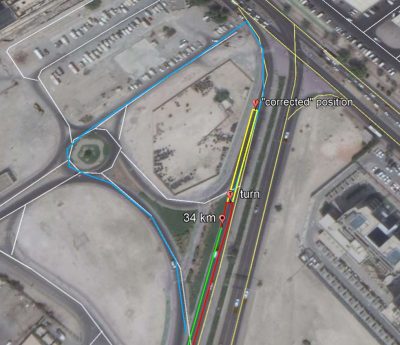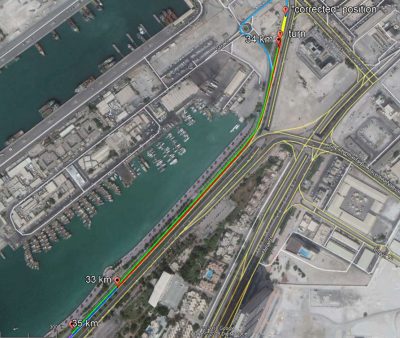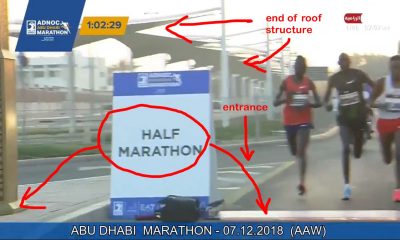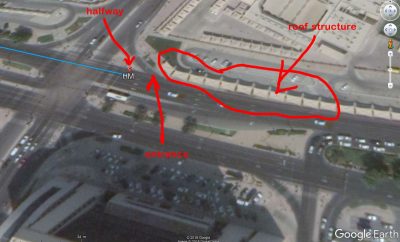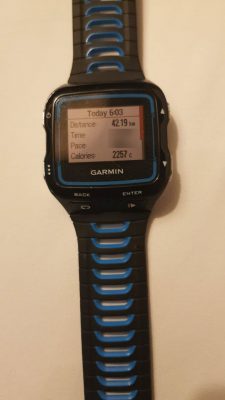German Expert Believes The Abu Dhabi Marathon Was Between 120 and 130 Meters Short
by Robert Johnson
December 12, 2018
On Friday, in our recap of the inaugural Abu Dhabi Marathon, we wondered if the course was the proper distance, writing, “Based on the fact the splits above defy credibility, we have zero confidence right now the marathon was the proper distance.” Later that day, I went a step further and published a video where I stated I believed the course was short and produced a video showing how the course didn’t 100% match the video course tour provided by race organizers.
To us, it was clear something had to be off as in a superfast, non-tactical marathon, humans are incapable of producing a 13:55 5k split between 30 and 35k in a race that isn’t aided by a significant elevation drop or wind (well certainly humans not named Eliud Kipchoge). The women’s winner’s split from 30 to 35k was almost as mind-boggling (15:55 – although Paula Radcliffe had a 3.1-mile segment in her 2:15:25 WR that was basically that pace). To us, it seemed unlikely that the 35k split was simply placed too early as the next split between 35k and 40k wasn’t longer than it should have been.
I wanted to give you an update on what has happened since then.
For transparency’s sake, I want to first off admit I made a mathematical error in my video, which I explain at the bottom of this article.*
The problem with my error in math is that while I still believed the course was short, I no longer had a good idea of how short it was.
Thankfully, some titans in the world of course measurement saw my video and one of them, Helmut Winter, decided to help me out. Winter, the German “Professor of Marathon” (actually a retired professor of physics at Humboldt University of Berlin) who has developed, together with his US counterpart Sean Hartnett, the “Pace Display System” in order to assist top athletes with timing information during major marathon events around the globe (the system was used in 18 out of the 20 fastest times in marathon history, including recent world records by Wilson Kipsang, Dennis Kimetto, and Eliud Kipchoge in Berlin), went back and watched the race broadcast on the internet, closely looked at where the km splits were and plotted them on Google Earth. The nice thing about his analysis is the final 12.195 km of the race is incredibly easy to measure as it was an out and back with a single left turn just before the finish. The conclusion from his analysis is the course was about 120 to 130m short between 33 and 34k because the turnaround point was placed at the wrong spot.
I should mention that Winter conducted a similar analysis on another marathon course for intermediate splits and found that those estimates were accurate within a range of a few meters. Here is the relevant portion of his email to me in full.
These are my conclusions in the moment:
Halfway split and all 5k splits before seem to be o.k. So I started my analysis of the course at half marathon.
I did some “measurements” with Google Earth. From half marathon to following markers the 33k marker was of particular interest and could be well identified in the video. I found 11913 m (Editor’s note: The actual number of meters between a half marathon and 33k is 11902.5m so the analysis is off by 10.5 m, but this is within the limits of error in the method used and not significant at all). This result implies that the length of the course from halfway to 33k was correct and that the 33k marker was on the correct position.
The main deficit happens on the course from 33k to 34k which is found to be only 878 m long. Then from 34 to 35 k a length of 1001 m is fully in line with the correct distance, and the same holds for the stretch from 35 k to finish where the analysis yields 7194m (Editor’s note: There are supposed to be 7195 m between 35k and finish).
Conclusion: All markers at 33k, 34k, and 35k were on correct positions, only the distance between 33k and 34k was short by about 120 to 130 m. [Editor’s note: because the turnaround point between 33k and 34k was placed too soon]. So the distance from 30 km to 35 km was not 5000 m but 4878 m. This might explain the superfast 5 km of 13:55 by the leaders
Main reason for the too short course seems to be the wrong position of the turning point close to the 34k marker. I have indicated in the graphs the distance where the correct turning point should have been positioned. So the results cannot find entrance in the best lists. What a pity!
Hope to receive a statement from the organizers on this issue soon. Irrespective of this problem which can be easily avoided in the future, I see a bright future for this event. Taking same U-turns out, it is certainly one of the fastest courses in the world.
(Editor’s note: See Winter’s attachments below)
|
The next two pictures show you how he places his markers. |
If the course was 120 to 130 meters short, that would only be 21.2 to 23.0 seconds short for someone running 2:04:30 pace. So that would change the winning time to something like 2:04:26 or 2:04:28 and the 13:55 split from 30 to 35k into something like 14:16 to 14:18, which is still is very, very fast.
In the meantime, we’ve been trying to get an official statement from the race organizers and to get a copy of the race’s certification report. Multiple emails to the race website haven’t been returned, but I did see a facebook post from Steve Watson, the race director of the Abu Dhabi Half Marathon and someone who works on all mass participation events in Abu Dhabi. Mr. Watson is also the head of the Abu Dhabi Striders Club. On Friday, Mr. Watson was not the race director for the marathon but his job was to “manage the timing and results service.” Mr. Watson posted on Facebook the discrepancies between the online course tour and actual race day footage wasn’t significant as the course map and video were “promotional” pieces that were produced well before the course was officially certified.
Additionally, a number of people have been emailing and posting on facebook that they believe the course was the accurate length because their GPS watches/Strava accounts show a length longer than a marathon. I was even sent a picture from an agent of a top pro’s watch in Abu Dhabi, which showed a 42.19 km distance (see photo below).
I’m sorry, Strava/GPS data isn’t going to cut it. There is a reason why these courses are officially measured. I’m not surprised that everyone’s Strava data shows a distance of 42.195km or longer. The whole point of measuring a course for certification is to make sure so that if everyone runs the tangents, then they run at least 42.195 km, but no one is going to run the tangents perfectly so most are going to get a longer distance.
An analysis of nearly 7,000 GPS watches for the London Marathon showed a median distance of 26.34 miles.
If we are going to go by Strava/watch data, then how about this email I got from the husband of a competitor if Abu Dhabi:
My wife actually mentioned she noticed during the run because the Garmin Forerunner gives 1k splits, which were a meter or two within the signs during the entire route, but at the 34k sign the watch only gave here 34k split about 200m later.
Strava data isn’t going to cut it. Google Earth is much more accurate than Strava and I’m convinced that from 30k to the finish the proper distance was not run. Since the final 12.195km was an out and back with a single left-hand turn before the finish, it’s easy to measure and Mr. Winter’s measurement is convincing to me.
If the race wants us to believe otherwise, it needs to see the official measurer’s report. The good news is that Carlos Fernandez Canet writes in Race Results Weekly that an “investigation is being conducted by the Athletics Integrity Unit.”
*Error in math in my original video: I said I thought the course was at least 53 seconds short because I thought the 34k split was in the right spot based on the time elapsed from 30 to 34k, which I said was 11:50 (or 11:58 if you thought the 34k split was just after the 180-degree turn, not right before it). In reality, the time elapsed between 30 and 34k was just 10:50 or 10:58 (not 11:50 or 11:58), which means that if you believe the splits, you have to believe they ran the 4k from 30 to 34k at an even more mind-boggling pace — 13:32 or 13:42 pace (depending if the split is before or after the 180-degree turn) before running a much slower 2:57 or 3:05 for the k between 34 and 35k. Clearly, that’s absurd and didn’t happen.
Do you think it was short? Email us or tell us whether you think it’s short on our world famous messageboard/fan forum below:
MB: Length matters: Here’s why I believe the Abu Dhabi course was short

